Application of Calcium Sulfate Whiskers to Cement-Based Materials: A Review
Abstract
:1. Introduction
2. Preparation Methods and Basic Properties of Calcium Sulfate Whisker Materials
2.1. Preparation Methods of CSWs
2.1.1. Preparation of CSWs by the Hydrothermal Method
2.1.2. Preparation of CSWs by Normal Pressure Acidification Method
2.1.3. Ion Exchange Method
2.1.4. Microemulsion Method
2.1.5. Microwave Method
2.1.6. Comparison of Methods
2.1.7. Factors That May Affect the CSWs Preparation Process
- (1)
- Temperature is a key parameter in whisker growth. Lower temperatures typically facilitate the growth of elongated whiskers, whereas higher temperatures may cause changes in the crystal shape. Controlling the temperature is crucial for adjusting the whisker shape.
- (2)
- The pH of the solution plays a crucial role in the formation and growth of CSWs. Different pH conditions can either promote or inhibit whisker growth.
- (3)
- Solution concentration: CSWs typically grow in supersaturated solutions. Altering the concentration of calcium sulfate in the solution affects the growth rate and whisker morphology.
- (4)
- Ion concentration: The concentrations of other ions dissolved in the solution, such as calcium and sulfate ions, also affect the formation of CSWs. The relative concentrations and ratios of these ions can alter the appearance of whiskers.
- (5)
- Stirring speed: The stirring speed can influence the quality and uniformity of crystal growth during the process. Adequate stirring promotes uniform crystal growth.
- (6)
- Substrate and crystal seeds: Using an appropriate substrate or crystal seed can aid the growth of CSWs.
- (7)
- Time: CSWs growth requires a certain amount of time, and the duration of this process can affect the whisker length and morphology.
- (8)
- Impurities and modifiers: Occasionally, the addition of specific modifiers or impurities can be employed to adjust the morphology of whiskers to better meet specific requirements.
- (9)
- Atmospheric conditions: In certain cases, atmospheric conditions, such as oxygen and carbon dioxide, may influence the formation of CSWs.
2.2. Basic Properties and Morphology of CSWs
3. The Application of CSWs to Cement and the Difference from Gypsum and Fiber
3.1. The Role of CSWs in Cement
3.2. Hydration Mechanism of CSWs
3.3. Effect of CSWs on Mechanical Properties
3.4. Changes in Mechanical Properties of CSWs at High Temperatures
3.5. Comparison of CSWs with Gypsum and Fiber
4. Potential Benefits of CSWs
4.1. Optimal Utilization in the Construction Industry
4.2. In the Field of Environmental Protection
4.3. Advantages and Disadvantages in the Field of Building Materials
5. Practical Applications and Prospects
5.1. Applications in the Construction and Cement Industries
5.2. Applications in the Field of Environmental Protection
5.3. Applications in the Field of Building Materials
6. Conclusions
- (1)
- CSWs are primarily produced by hydrothermal and atmospheric-pressure acidification, ion exchange, microemulsion, and microwave methods. The raw materials required include high-calcium industrial solid waste.
- (2)
- As a reinforcing material, CSWs can significantly enhance the tensile strength, compressive strength, and durability of the CBM, thereby improving their load-bearing capacity.
- (3)
- The judicious use of CSWs can effectively reduce the shrinkage of the CBM, enhance the volume stability of its materials, and mitigate the occurrence of cracks. This improves material durability and reduces structural maintenance costs. The optimal amount for achieving the best improvement in the mechanical properties is typically in the range of 4 to 6 wt.%.
- (4)
- The presence of CSWs affects the microstructure of the CBM, forming a dense lattice structure and enhancing the overall performance of the material.
- (5)
- The use of CSWs helps decrease dependence on natural resources and enhances the environmental friendliness of the CBM.
Author Contributions
Funding
Institutional Review Board Statement
Informed Consent Statement
Data Availability Statement
Conflicts of Interest
References
- Dalmay, P.; Smith, A.; Chotard, T.; Sahay-Turner, P.; Gloaguen, V.; Krausz, P. Properties of Cellulosic Fibre Reinforced Plaster: Influence of Hemp or Flax Fibres on the Properties of Set Gypsum. J. Mater. Sci. 2010, 45, 793–803. [Google Scholar] [CrossRef]
- Ferrari, V.J.; De Hanai, J.B.; De Souza, R.A. Flexural Strengthening of Reinforcement Concrete Beams Using High Performance Fiber Reinforcement Cement-Based Composite (HPFRCC) and Carbon Fiber Reinforced Polymers (CFRP). Constr. Build. Mater. 2013, 48, 485–498. [Google Scholar] [CrossRef]
- Koralegedara, N.H.; Pinto, P.X.; Dionysiou, D.D.; Al-Abed, S.R. Recent Advances in Flue Gas Desulfurization Gypsum Processes and Applications—A Review. J. Environ. Manag. 2019, 251, 109572. [Google Scholar] [CrossRef]
- Graham, R.K.; Huang, B.; Shu, X.; Burdette, E.G. Laboratory Evaluation of Tensile Strength and Energy Absorbing Properties of Cement Mortar Reinforced with Micro- and Meso-Sized Carbon Fibers. Constr. Build. Mater. 2013, 44, 751–756. [Google Scholar] [CrossRef]
- Dong, F.; Huang, Z.; Tan, H.; Wu, C.; He, P. Effect of Additives on Calcium Sulfate Hemihydrate Whiskers Morphology from Calcium Sulfate Dehydrate and Phosphogypsum. Mater. Manuf. Process. 2016, 31, 2037–2043. [Google Scholar] [CrossRef]
- Suárez, F.; Felipe-Sesé, L.; Díaz, F.A.; Gálvez, J.C.; Alberti, M.G. On the Fracture Behaviour of Fibre-Reinforced Gypsum Using Micro and Macro Polymer Fibres. Constr. Build. Mater. 2020, 244, 118347. [Google Scholar] [CrossRef]
- Ahn, J.W.; Eun, H.T.; Kim, H.S.; Kim, J.S.; Sung, G.W. Preparation of Calcium Sulfate Hemihydrate Using Stainless Steel Refinery Sludge and Waste Sulfuric Acid. Geosystem. Eng. 2001, 4, 71–76. [Google Scholar] [CrossRef]
- Wan, L.; Pan, R.; Xu, J. Mechanical Properties and Microstructure of CaSO4 Whisker Reinforced Cement Mortar. J. Wuhan Univ. Technol.-Mat. Sci. Edit. 2019, 34, 1170–1176. [Google Scholar] [CrossRef]
- Li, X.; Li, L.; Zhang, C.; Zheng, Y. Experimental Study on Basic Mechanical Properties of Calcium Sulfate Whisker-Reinforced Cement. IOP Conf. Ser. Mater. Sci. Eng. 2020, 735, 012036. [Google Scholar] [CrossRef]
- Cao, K.; Liu, G.; Li, H.; Huang, Z. Mechanical Properties and Microstructure of Calcium Sulfate Whisker-Reinforced Cement-Based Composites. Materials 2022, 15, 947. [Google Scholar] [CrossRef]
- Zhang, J.; Jin, J.; Guo, B.; Wang, J.; Fu, C.; Zhang, Y. Effect of Mixed Basalt Fiber and Calcium Sulfate Whisker on Chloride Permeability of Concrete. J. Build. Eng. 2023, 64, 105633. [Google Scholar] [CrossRef]
- Cheng, X.; Dong, Q.; Li, Z.; Guo, X. High-Temperature Mechanical Properties of Calcium Sulfate Whisker-Reinforced High-Alumina Cement. Mag. Concr. Res. 2020, 72, 55–67. [Google Scholar] [CrossRef]
- Zhu, Z.; Xu, L.; Chen, G. Effect of Different Whiskers on the Physical and Tribological Properties of Non-Metallic Friction Materials. Mater. Des. 2011, 32, 54–56. [Google Scholar] [CrossRef]
- Fukugaichi, S.; Matsue, N. One-Step Synthesis of Calcium Sulfate Hemihydrate Nanofibers from Calcite at Room Temperature. ACS Omega 2018, 3, 2820–2824. [Google Scholar] [CrossRef]
- Sivakumar, A.; Santhanam, M. Mechanical Properties of High Strength Concrete Reinforced with Metallic and Non-Metallic Fibres. Cem. Concr. Compos. 2007, 29, 603–608. [Google Scholar] [CrossRef]
- Ukawa, N.; Takashina, T.; Shinoda, N.; Shimizu, T. Effects of Particle Size Distribution on Limestone Dissolution in Wet FGD Process Applications. Environ. Prog. 1993, 12, 238–242. [Google Scholar] [CrossRef]
- Feldmann, T.; Demopoulos, G.P. The Crystal Growth Kinetics of Alpha Calcium Sulfate Hemihydrate in Concentrated CaCl2–HCl Solutions. J. Cryst. Growth 2012, 351, 9–18. [Google Scholar] [CrossRef]
- Lei, M.; Ma, B.; Lv, D.; Wang, C.; Asselin, E.; Chen, Y. A Process for Beneficiation of Low-Grade Manganese Ore and Synchronous Preparation of Calcium Sulfate Whiskers during Hydrochloric Acid Regeneration. Hydrometallurgy 2021, 199, 105533. [Google Scholar] [CrossRef]
- Rashad, M.M.; Mahmoud, M.H.H.; Ibrahim, I.A.; Abdel-Aal, E.A. Crystallization of Calcium Sulfate Dihydrate under Simulated Conditions of Phosphoric Acid Production in the Presence of Aluminum and Magnesium Ions. J. Cryst. Growth 2004, 267, 372–379. [Google Scholar] [CrossRef]
- Hamdona, S.K.; Al Hadad, U.A. Crystallization of Calcium Sulfate Dihydrate in the Presence of Some Metal Ions. J. Cryst. Growth 2007, 299, 146–151. [Google Scholar] [CrossRef]
- Hazra, C.; Bari, S.; Kundu, D.; Chaudhari, A.; Mishra, S.; Chatterjee, A. Ultrasound-Assisted/Biosurfactant-Templated Size-Tunable Synthesis of Nano-Calcium Sulfate with Controllable Crystal Morphology. Ultrason. Sonochem. 2014, 21, 1117–1131. [Google Scholar] [CrossRef] [PubMed]
- Bakshi, P.; Pappu, A.; Kumar Bharti, D. Transformation of Flue Gas Desulfurization (FGD) Gypsum to β-CaSO4·0.5H2O Whiskers Using Facile Water Treatment. Mater. Lett. 2022, 308, 131177. [Google Scholar] [CrossRef]
- Liu, C.; Zhao, Q.; Wang, Y.; Shi, P.; Jiang, M. Hydrothermal Synthesis of Calcium Sulfate Whisker from Flue Gas Desulfurization Gypsum. Chin. J. Chem. Eng. 2016, 24, 1552–1560. [Google Scholar] [CrossRef]
- Yang, L.S.; Wang, X.; Zhu, X.F.; Du, L.Z. Preparation of Calcium Sulfate Whisker by Hydrothermal Method from Flue Gas Desulfurization (FGD) Gypsum. AMM 2012, 268–270, 823–826. [Google Scholar] [CrossRef]
- Miao, M.; Feng, X.; Wang, G.; Cao, S.; Shi, W.; Shi, L. Direct Transformation of FGD Gypsum to Calcium Sulfate Hemihydrate Whiskers: Preparation, Simulations, and Process Analysis. Particuology 2015, 19, 53–59. [Google Scholar] [CrossRef]
- Luo, K.B.; Li, H.P.; Tan, Y.X. Study on the Preparation of Calcium Sulfate Whisker by Hydrothermal Method. AMR 2012, 602–604, 1369–1372. [Google Scholar] [CrossRef]
- Wang, Y.; Li, Y.; Yuan, A.; Yuan, B.; Lei, X.; Ma, Q.; Han, J.; Wang, J.; Chen, J. Preparation of Calcium Sulfate Whiskers by Carbide Slag through Hydrothermal Method. Cryst. Res. Technol. 2014, 49, 800–807. [Google Scholar] [CrossRef]
- Zhou, D.; Wei, R.; Zhu, Y.; Long, H.; Huang, B.; Wang, Y.; Wu, S. Calcium Sulfate Whisker One-Step Preparation Using Semi-Dry Flue Gas Desulfurization Ash and Directional Growth Control. J. Clean. Prod. 2021, 290, 125754. [Google Scholar] [CrossRef]
- Abdel-Aal, E.A.; Rashad, M.M.; El-Shall, H. Crystallization of Calcium Sulfate Dihydrate at Different Supersaturation Ratios and Different Free Sulfate Concentrations. Cryst. Res. Technol. 2004, 39, 313–321. [Google Scholar] [CrossRef]
- Wang, L.; Zhuang, C.Y.; Meng, D.Q. Study on Preparation of Calcium Sulfate Whisker with Leaching Tailings of Nickel Ore. AMR 2011, 287–290, 2084–2087. [Google Scholar] [CrossRef]
- Chen, S.; Fu, J.; He, X.; Su, Y.; Xiong, G.; Liu, Q.; Huang, Z.; Jiang, Y. Microemulsion Synthesis of Anhydrous Calcium Sulfate Nanowhiskers with Calcium Acetate Solution and Its Surface Structure Stable and Crystal Phase Evolution after Modification. J. Nanopart. Res. 2020, 22, 193. [Google Scholar] [CrossRef]
- Feldmann, T.; Demopoulos, G.P. Influence of Impurities on Crystallization Kinetics of Calcium Sulfate Dihydrate and Hemihydrate in Strong HCl-CaCl2 Solutions. Ind. Eng. Chem. Res. 2013, 52, 6540–6549. [Google Scholar] [CrossRef]
- Sun, H.; Tan, D.; Peng, T.; Liang, Y. Preparation of Calcium Sulfate Whisker by Atmospheric Acidification Method from Flue Gas Desulfurization Gypsum. Procedia Environ. Sci. Eng. Manag. 2016, 31, 621–626. [Google Scholar] [CrossRef]
- Ma, B.; Xing, P.; Wang, C.; Chen, Y.; Shao, S. A Novel Way to Synthesize Calcium Sulfate Whiskers with High Aspect Ratios from Concentrated Calcium Nitrate Solution. Mater. Lett. 2018, 219, 1–3. [Google Scholar] [CrossRef]
- Wang, X.; Wang, L.; Wang, Y.; Tan, R.; Ke, X.; Zhou, X.; Geng, J.; Hou, H.; Zhou, M. Calcium Sulfate Hemihydrate Whiskers Obtained from Flue Gas Desulfurization Gypsum and Used for the Adsorption Removal of Lead. Crystals 2017, 7, 270. [Google Scholar] [CrossRef]
- Li, X.; Han, J.; Liu, Y.; Dou, Z.; Zhang, T. Summary of Research Progress on Industrial Flue Gas Desulfurization Technology. Sep. Purif. Technol. 2022, 281, 119849. [Google Scholar] [CrossRef]
- Zhang, Y.; Yang, L.; Liu, X.; Cao, J. Effect of HF, H2SiF6, and Al3+ Ions on the Crystal Growth Process and Morphology of α-Type Hemihydrate Calcium Sulfate in Phosphoric Acid Solution. J. Cryst. Growth 2023, 603, 127000. [Google Scholar] [CrossRef]
- Kim, Y.B.; Gwak, Y.R.; Keel, S.I.; Yun, J.H.; Lee, S.H. Direct Desulfurization of Limestones under Oxy-Circulating Fluidized Bed Combustion Conditions. Chem. Eng. J. 2019, 377, 119650. [Google Scholar] [CrossRef]
- Chen, S.; Liu, Q.; He, X.; Su, Y.; Zhang, B.; Xu, H. One-Step Synthesis of Nanoscale Anhydrous Calcium Sulfate Whiskers: Direct Conversion of Calcium Carbonate by Mixed Acid with Microemulsion Method. J. Nanopart. Res. 2022, 24, 4. [Google Scholar] [CrossRef]
- Zhang, X.; Wang, J.; Wu, J.; Jia, X.-J.; Du, Y.; Li, H.; Zhao, B. Phase- and Morphology-Controlled Crystallization of Gypsum by Using Flue-Gas-Desulfurization Gypsum Solid Waste. J. Alloys Compd. 2016, 674, 200–206. [Google Scholar] [CrossRef]
- Chen, S.; Jiang, Y.; Xu, Y.; Fu, J.; He, X.; Su, Y.; Wang, X.; Strnadel, B. Micro-Environment Regulation Synthesis of Calcium Sulfate Nanoparticles and Its Water Removal Application. Mater. Res. Express 2019, 6, 1050b8. [Google Scholar] [CrossRef]
- Yang, H.-C.; Tsai, T.-P.; Hsieh, C.-T. Enhancement on Fireproof Performance of Construction Coatings Using Calcium Sulfate Whiskers Prepared from Wastewater. Chem. Pap. 2017, 71, 1343–1350. [Google Scholar] [CrossRef]
- Feng, Y.; Guo, R.; Lin, Z. Effect of Aluminum Sulfate and Succinic Acid on the Growth Law of α-Calcium Sulfate Hemihydrate under Microwave Irradiation. Adv. Mater. Sci. Eng. 2021, 2021, 6630638. [Google Scholar] [CrossRef]
- Chemat-Djenni, Z.; Hamada, B.; Chemat, F. Atmospheric Pressure Microwave Assisted Heterogeneous Catalytic Reactions. Molecules 2007, 12, 1399–1409. [Google Scholar] [CrossRef] [PubMed]
- Yang, H.-C.; Tsai, T.-P. Microwave-Assisted Synthesis and Thermal Resistance of Calcium Sulfate Whiskers. Chem. Eng. Commun. 2017, 204, 232–237. [Google Scholar] [CrossRef]
- El Moussaouiti, M.; Boistelle, R.; Bouhaouss, A.; Klein, J.P. Crystallization of Calcium Sulphate Hemihydrate in Concentrated Phosphoric Acid Solutions. Chem. Eng. J. 1997, 68, 123–130. [Google Scholar] [CrossRef]
- Koopman, C.; Witkamp, G.J. Ion Exchange Extraction during Continuous Recrystallization of CaSO4 in the Phosphoric Acid Production Process: Lanthanide Extraction Efficiency and CaSO4 Particle Shape. Hydrometallurgy 2002, 63, 137–147. [Google Scholar] [CrossRef]
- Martynowicz, E.T.M.J.; Liao, L.; Witkamp, G.-J.; Van Rosmalen, G.M. The Influence of Aluminium Fluoride in Hemi-Dihydrate Phosphoric Acid Processes. Hydrometallurgy 1996, 41, 155–170. [Google Scholar] [CrossRef]
- Azimi, G.; Papangelakis, V.G.; Dutrizac, J.E. Modelling of Calcium Sulphate Solubility in Concentrated Multi-Component Sulphate Solutions. Fluid Phase Equilib. 2007, 260, 300–315. [Google Scholar] [CrossRef]
- Xu, Y.; Xu, Y. Comparative Study on Pavement Performance of Asphalt Mixtures Modified by Calcium Sulfate Whisker and Calcium Carbonate Whisker. Coatings 2022, 12, 1513. [Google Scholar] [CrossRef]
- Feldmann, T.; Demopoulos, G.P. Effects of Crystal Habit Modifiers on the Morphology of Calcium Sulfate Dihydrate Grown in Strong CaCl2-HCl Solutions. J. Chem. Technol. Biotechnol. 2014, 89, 1523–1533. [Google Scholar] [CrossRef]
- Chakraborty, S.; Kundu, S.P.; Roy, A.; Basak, R.K.; Adhikari, B.; Majumder, S.B. Improvement of the Mechanical Properties of Jute Fibre Reinforced Cement Mortar: A Statistical Approach. Constr. Build. Mater. 2013, 38, 776–784. [Google Scholar] [CrossRef]
- Akhtar, T.; Ali, B.; Ben Kahla, N.; Kurda, R.; Rizwan, M.; Mohsin Javed, M.; Raza, A. Experimental Investigation of Eco-Friendly High Strength Fiber-Reinforced Concrete Developed with Combined Incorporation of Tyre-Steel Fiber and Fly Ash. Constr. Build. Mater. 2022, 314, 125626. [Google Scholar] [CrossRef]
- Saulat, H.; Cao, M.; Khan, M.M.; Khan, M.; Khan, M.M.; Rehman, A. Preparation and Applications of Calcium Carbonate Whisker with a Special Focus on Construction Materials. Constr. Build. Mater. 2020, 236, 117613. [Google Scholar] [CrossRef]
- Wang, H.; Zeng, X.; Liu, Z.; Luan, S.; Tang, Z.; Long, G.; Tan, Q.; Wang, H.; Liu, S.; Ren, X.; et al. Effect of Nano-SiO2/CaSO4 Whisker–Silica Fume on the Strength, Drying Shrinkage, and Capillary Water Absorption of Cement Mortar. Archiv. Civ. Mech. Eng. 2023, 24, 13. [Google Scholar] [CrossRef]
- Lee, B.; Kim, G.; Nam, J.; Lee, K.; Kim, G.; Lee, S.; Shin, K.; Koyama, T. Influence of α-Calcium Sulfate Hemihydrate on Setting, Compressive Strength, and Shrinkage Strain of Cement Mortar. Materials 2019, 12, 163. [Google Scholar] [CrossRef]
- Wu, L.; Zhang, J.; Zhou, L.; Nie, Q.; Wu, H. Effects of Calcium Sulfate Whiskers and Basalt Fiber on Gas Permeability and Microstructure of Concrete. SSRN 2023, 27. [Google Scholar] [CrossRef]
- Varona, F.B.; Baeza, F.J.; Bru, D.; Ivorra, S. Influence of High Temperature on the Mechanical Properties of Hybrid Fibre Reinforced Normal and High Strength Concrete. Constr. Build. Mater. 2018, 159, 73–82. [Google Scholar] [CrossRef]
- Bhat, M.D.; Rehman, M.U.; Shafi, I.; Parveen, A.; Fayaz, A.; Malik, B.A.; Bashir, F. The Effect of Polypropylene and Steel Fibers on the Properties of Concrete at Normal and Elevated Temperatures—A Review. Iran J. Sci. Technol. Trans. Civ. Eng. 2022, 46, 1805–1823. [Google Scholar] [CrossRef]
- Zhang, B.; Peng, Z.; Zou, C.; Feng, Q.; Zhang, J. Study on Surface Modification of CaSO4 Whisker and Mechanism of Enhancing Mechanical Properties of Oil-Well Cement. Colloids Surf. A Physicochem. Eng. Asp. 2021, 618, 126408. [Google Scholar] [CrossRef]
- O’Rourke, B.; McNally, C.; Richardson, M.G. Development of Calcium Sulfate–Ggbs–Portland Cement Binders. Constr. Build. Mater. 2009, 23, 340–346. [Google Scholar] [CrossRef]
- Islam, G.M.S.; Chowdhury, F.H.; Raihan, M.T.; Amit, S.K.S.; Islam, M.R. Effect of Phosphogypsum on the Properties of Portland Cement. Procedia Eng. 2017, 171, 744–751. [Google Scholar] [CrossRef]
- Li, Z.; Wang, X.; Hou, Y.; Wu, Z. Optimization of Mechanical Properties and Water Absorption Behavior of Building Gypsum by Ternary Matrix Mixture. Constr. Build. Mater. 2022, 350, 128910. [Google Scholar] [CrossRef]
- Torréns-Martín, D.; Fernández-Carrasco, L. Effect of Sulfate Content on Cement Mixtures. Constr. Build. Mater. 2013, 48, 144–150. [Google Scholar] [CrossRef]
- Taher, M.A. Influence of Thermally Treated Phosphogypsum on the Properties of Portland Slag Cement. Resour. Conserv. Recycl. 2007, 52, 28–38. [Google Scholar] [CrossRef]
- Gunay, S.; Garrault, S.; Nonat, A.; Termkhajornkit, P. Influence of Calcium Sulphate on Hydration and Mechanical Strength of Tricalcium Silicate. In Proceedings of the 13th International Congress on the Chemistry of Cement, Madrid, Spain, 3–8 July 2011. [Google Scholar]
- Tzouvalas, G.; Dermatas, N.; Tsimas, S. Alternative Calcium Sulfate-Bearing Materials as Cement Retarders. Cem. Concr. Res. 2004, 34, 2113–2118. [Google Scholar] [CrossRef]
- Evju, C.; Hansen, S. Expansive Properties of Ettringite in a Mixture of Calcium Aluminate Cement, Portland Cement and b-Calcium Sulfate Hemihydrate. Cem. Concr. Res. 2001, 31, 257–261. [Google Scholar] [CrossRef]
- Camarini, G.; De Milito, J.A. Gypsum Hemihydrate–Cement Blends to Improve Renderings Durability. Constr. Build. Mater. 2011, 25, 4121–4125. [Google Scholar] [CrossRef]
- Pourchet, S.; Regnaud, L.; Perez, J.P.; Nonat, A. Early C3A Hydration in the Presence of Different Kinds of Calcium Sulfate. Cem. Concr. Res. 2009, 39, 989–996. [Google Scholar] [CrossRef]
- Andrade Neto, J.D.S.; De La Torre, A.G.; Kirchheim, A.P. Effects of Sulfates on the Hydration of Portland Cement—A Review. Constr. Build. Mater. 2021, 279, 122428. [Google Scholar] [CrossRef]
- Nawaz, M.A.; Ali, B.; Qureshi, L.A.; Usman Aslam, H.M.; Hussain, I.; Masood, B.; Raza, S.S. Effect of Sulfate Activator on Mechanical and Durability Properties of Concrete Incorporating Low Calcium Fly Ash. Case Stud. Constr. Mater. 2020, 13, e00407. [Google Scholar] [CrossRef]
- Ouyang, C.; Nanni, A.; Chang, W.F. Internal and External Sources of Sulfate Ions in Portland Cement Mortar: Two Types of Chemical Attack. Cem. Concr. Res. 1988, 18, 699–709. [Google Scholar] [CrossRef]
- Chandara, C.; Azizli, K.A.M.; Ahmad, Z.A.; Sakai, E. Use of Waste Gypsum to Replace Natural Gypsum as Set Retarders in Portland Cement. Waste Manag. 2009, 29, 1675–1679. [Google Scholar] [CrossRef]
- Shin, K.-S.; Kim, G.-Y.; Sung, G.-M.; Woo, S.-K.; Lim, B.-H. Mechanical Properties of Concrete using Alpha-Calcium Sulfate Hemihydrate. JKSMI 2019, 23, 72–79. [Google Scholar]
- Odler, I.; Gasser, M. Mechanism of Sulfate Expansion in Hydrated Portland Cement. JACerS 1988, 71, 1015–1020. [Google Scholar] [CrossRef]
- Tian, B.; Cohen, M.D. Does Gypsum Formation during Sulfate Attack on Concrete Lead to Expansion? Cem. Concr. Res. 2000, 30, 117–123. [Google Scholar] [CrossRef]
- Puri, A.; Voicu, G.; Badanoiu, A. Expansive Binders in the Portland Cement—Calcium Aluminate Cement—Calcium Sulfate System. Rev. Chim. 2010, 61, 740–744. [Google Scholar]
- Cao, H.T.; Bucea, L.; Ray, A.; Yozghatlian, S. The Effect of Cement Composition and pH of Environment on Sulfate Resistance of Portland Cements and Blended Cements. Cem. Concr. Compos. 1997, 19, 161–171. [Google Scholar] [CrossRef]
- Al-Amoudi, O.S.B. Sulfate Attack and Reinforcement Corrosion in Plain and Blended Cements Exposed to Sulfate Environments. Build. Environ. 1998, 33, 53–61. [Google Scholar] [CrossRef]
- Neville, A. The Confused World of Sulfate Attack on Concrete. Cem. Concr. Res. 2004, 34, 1275–1296. [Google Scholar] [CrossRef]
- Irassar, E.F.; Bonavetti, V.L.; González, M. Microstructural Study of Sulfate Attack on Ordinary and Limestone Portland Cements at Ambient Temperature. Cem. Concr. Res. 2003, 33, 31–41. [Google Scholar] [CrossRef]
- Hay, R.; Li, L.; Celik, K. Shrinkage, Hydration, and Strength Development of Limestone Calcined Clay Cement (LC3) with Different Sulfation Levels. Cem. Concr. Compos. 2022, 127, 104403. [Google Scholar] [CrossRef]
- Andrade Neto, J.S.; De Matos, P.R.; De La Torre, A.G.; Campos, C.E.M.; Torres, S.M.; Monteiro, P.J.M.; Kirchheim, A.P. Hydration and Interactions between Pure and Doped C3S and C3A in the Presence of Different Calcium Sulfates. Cem. Concr. Res. 2022, 159, 106893. [Google Scholar] [CrossRef]
- Maier, M.; Sposito, R.; Beuntner, N.; Thienel, K.-C. Particle Characteristics of Calcined Clays and Limestone and Their Impact on Early Hydration and Sulfate Demand of Blended Cement. Cem. Concr. Res. 2022, 154, 106736. [Google Scholar] [CrossRef]
- Liao, Y.; Yao, J.; Deng, F.; Li, H.; Wang, K.; Tang, S. Hydration Behavior and Strength Development of Supersulfated Cement Prepared by Calcined Phosphogypsum and Slaked Lime. J. Build. Eng. 2023, 80, 108075. [Google Scholar] [CrossRef]
- Rodriguez, C.; Tobon, J.I. Influence of Calcined Clay/Limestone, Sulfate and Clinker Proportions on Cement Performance. Constr. Build. Mater. 2020, 251, 119050. [Google Scholar] [CrossRef]
- Rubert, S.; Angulski Da Luz, C.; Varela, F.M.V.; Pereira Filho, J.I.; Hooton, R.D. Hydration Mechanisms of Supersulfated Cement: The Role of Alkali Activator and Calcium Sulfate Content. J. Therm. Anal. Calorim. 2018, 134, 971–980. [Google Scholar] [CrossRef]
- Whittaker, M.; Zajac, M.; Ben Haha, M.; Bullerjahn, F.; Black, L. The Role of the Alumina Content of Slag, plus the Presence of Additional Sulfate on the Hydration and Microstructure of Portland Cement-Slag Blends. Cem. Concr. Res. 2014, 66, 91–101. [Google Scholar] [CrossRef]
- Costa, A.R.D.; Matos, S.R.C.; Camarini, G.; Gonçalves, J.P. Hydration of Sustainable Ternary Cements Containing Phosphogypsum. SM&T 2021, 28, e00280. [Google Scholar]
- Yonggui, W.; Shuaipeng, L.; Hughes, P.; Yuhui, F. Mechanical Properties and Microstructure of Basalt Fibre and Nano-Silica Reinforced Recycled Concrete after Exposure to Elevated Temperatures. Constr. Build. Mater. 2020, 247, 118561. [Google Scholar] [CrossRef]
- Carraro, P.A.; Zappalorto, M.; Quaresimin, M. A Comprehensive Description of Interfibre Failure in Fibre Reinforced Composites. Theor. Appl. Fract. Mech. 2015, 79, 91–97. [Google Scholar] [CrossRef]
- Mwaba, M.G.; Gu, J.; Golriz, M.R. Effect of Magnetic Field on Calcium Sulfate Crystal Morphology. J. Cryst. Growth 2007, 303, 381–386. [Google Scholar] [CrossRef]
- Sanchez, F.; Sobolev, K. Nanotechnology in Concrete—A Review. Constr. Build. Mater. 2010, 24, 2060–2071. [Google Scholar] [CrossRef]
- Junwei, Z.; Shijie, L.; Hongjian, P. Experimental Investigation of Multiscale Hybrid Fibres on the Mechanical Properties of High-Performance Concrete. Constr. Build. Mater. 2021, 299, 123895. [Google Scholar] [CrossRef]
- Tzouvalas, G.; Rantis, G.; Tsimas, S. Alternative Calcium-Sulfate-Bearing Materials as Cement Retarders: Part II. FGD Gypsum. Cem. Concr. Res. 2004, 34, 2119–2125. [Google Scholar] [CrossRef]
- Zhao, C.; Wang, Z.; Zhu, Z.; Guo, Q.; Wu, X.; Zhao, R. Research on Different Types of Fiber Reinforced Concrete in Recent Years: An Overview. Constr. Build. Mater. 2023, 365, 130075. [Google Scholar] [CrossRef]
- Fan, T.; Si, C.; Zhang, Y.; Zhu, Y.; Li, S. Optimization Design of Asphalt Mixture Composite Reinforced with Calcium Sulfate Anhydrous Whisker and Polyester Fiber Based on Response Surface Methodology. Materials 2023, 16, 594. [Google Scholar] [CrossRef]
- Aakriti; Maiti, S.; Jain, N.; Malik, J. A Comprehensive Review of Flue Gas Desulphurized Gypsum: Production, Properties, and Applications. Constr. Build. Mater. 2023, 393, 131918. [Google Scholar] [CrossRef]
- Stawiski, B.; Kania, T. Examining the Distribution of Strength across the Thickness of Reinforced Concrete Elements Subject to Sulphate Corrosion Using the Ultrasonic Method. Materials 2019, 12, 2519. [Google Scholar] [CrossRef]
- Basista, M.; Weglewski, W. Micromechanical Modelling of Sulphate Corrosion in Concrete: Influence of Ettringite Forming Reaction. Theor. Appl. Mech. 2008, 35, 29–52. [Google Scholar] [CrossRef]
- Basista, M.; Weglewski, W. Chemically Assisted Damage of Concrete: A Model of Expansion Under External Sulfate Attack. Int. J. Damage Mech. 2009, 18, 155–175. [Google Scholar] [CrossRef]
- Hodhod, O.A.; Salama, G. Simulation of Expansion in Cement Based Materials Subjected to External Sulfate Attack. Ain. Shams Eng. J. 2014, 5, 7–15. [Google Scholar] [CrossRef]
- Wagner, M.; Decker, M.; Kunther, W.; Machner, A.; Beddoe, R.E.; Heisig, A.; Heinz, D. Gypsum Formation Mechanisms and Their Contribution to Crystallisation Pressure in Sulfate Resistant Hardened Cement Pastes during Early External Sulfate Attack at Low Sulfate Concentrations. Cem. Concr. Res. 2023, 168, 107138. [Google Scholar] [CrossRef]
- Horkoss, S.; Escadeillas, G.; Rizk, T.; Lteif, R. The Effect of the Source of Cement SO3 on the Expansion of Mortars. Case Stud. Constr. Mater. 2016, 4, 62–72. [Google Scholar]
- Talaber, J. Factors Influencing the Quality of Cement. Period. Polytech. Civ. Eng. 1982, 26, 27–39. [Google Scholar]
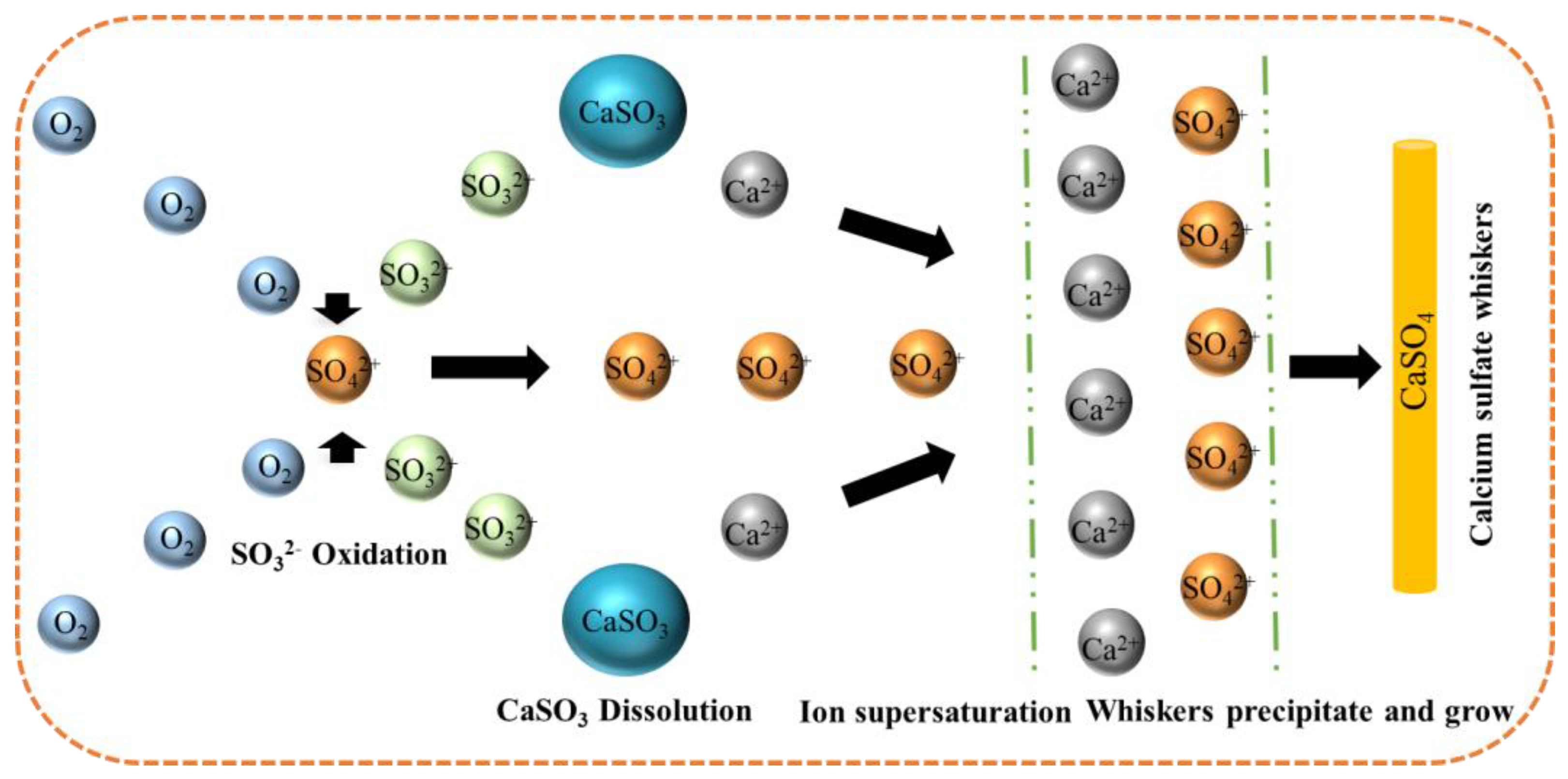

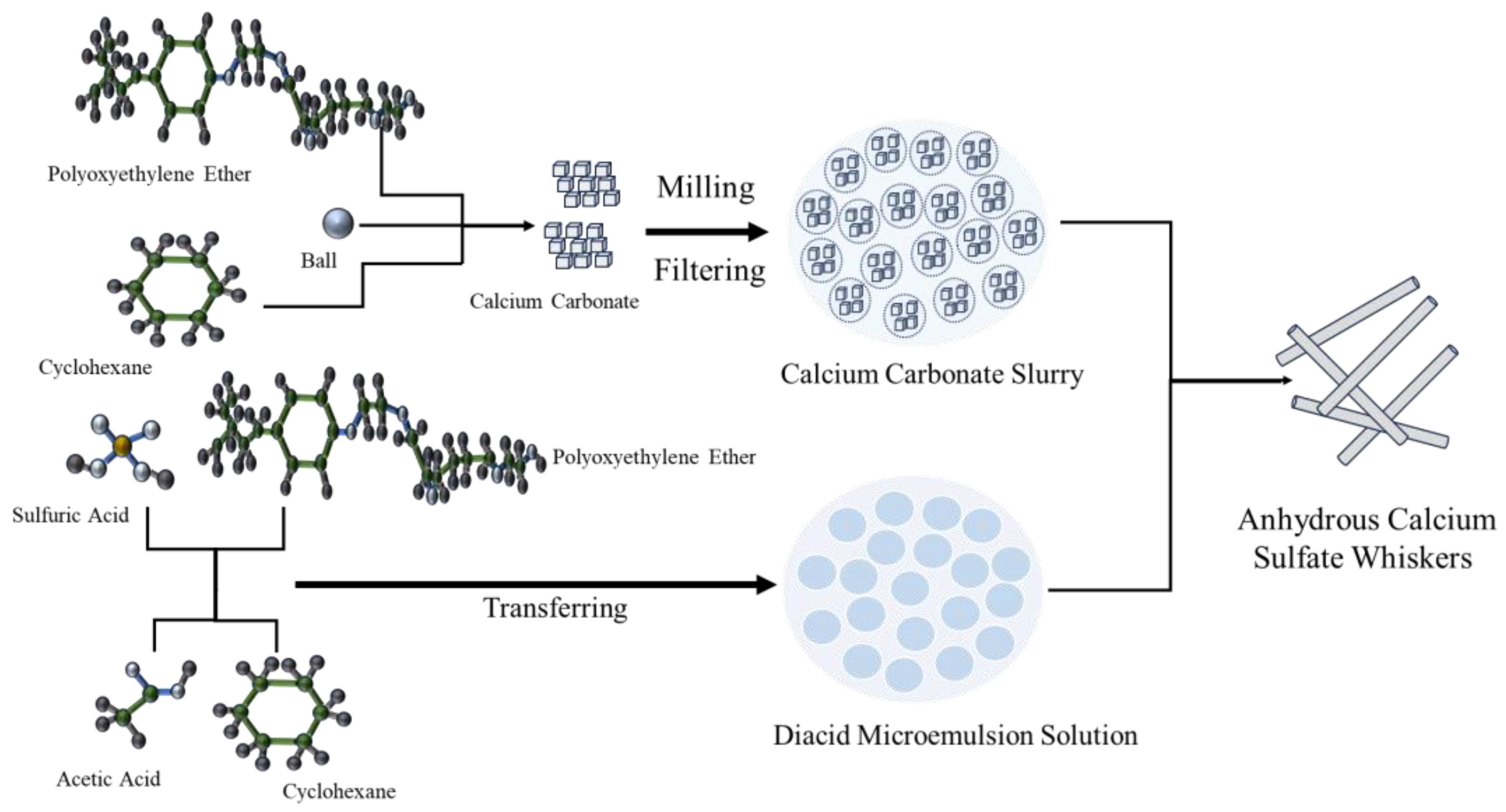
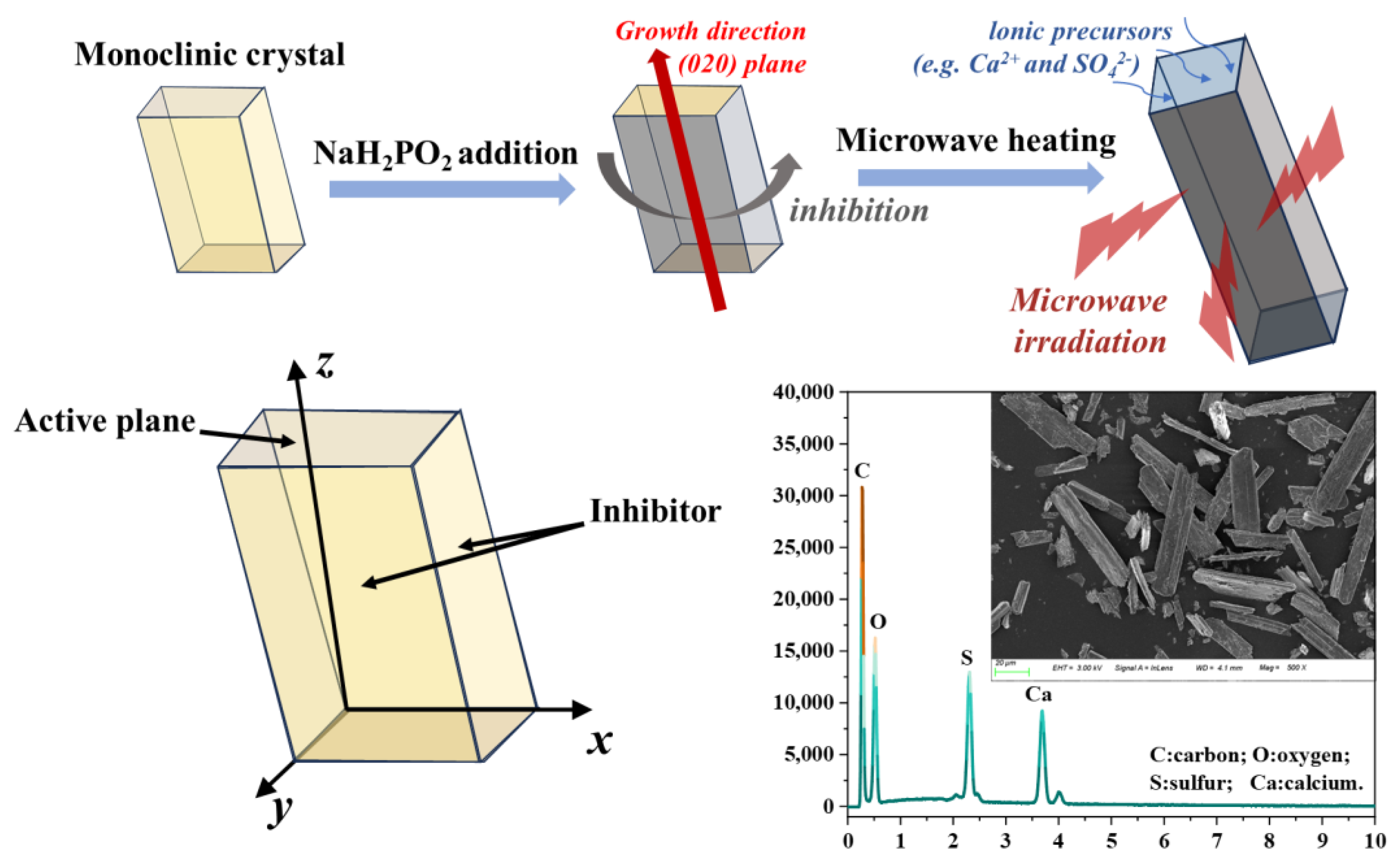
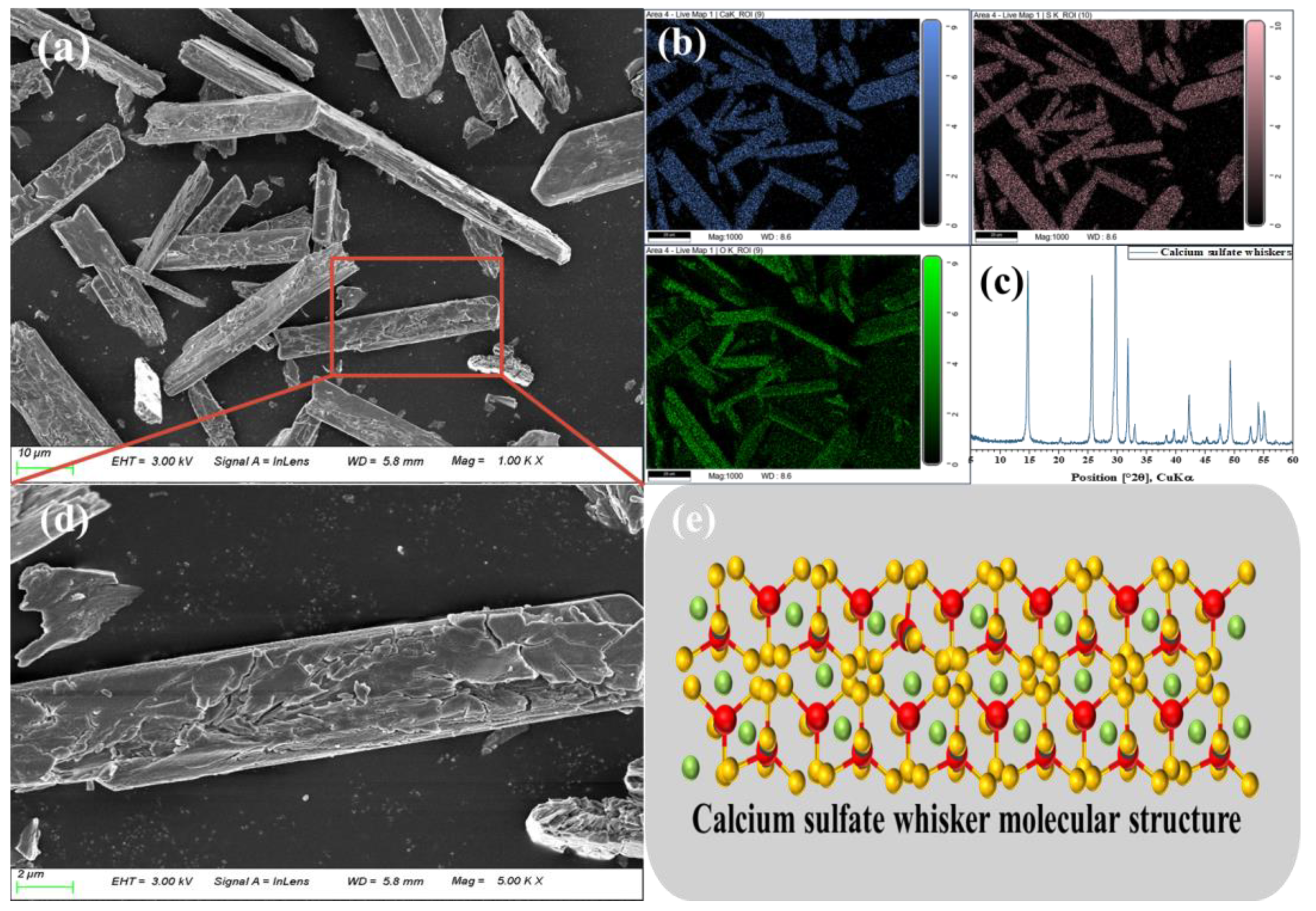

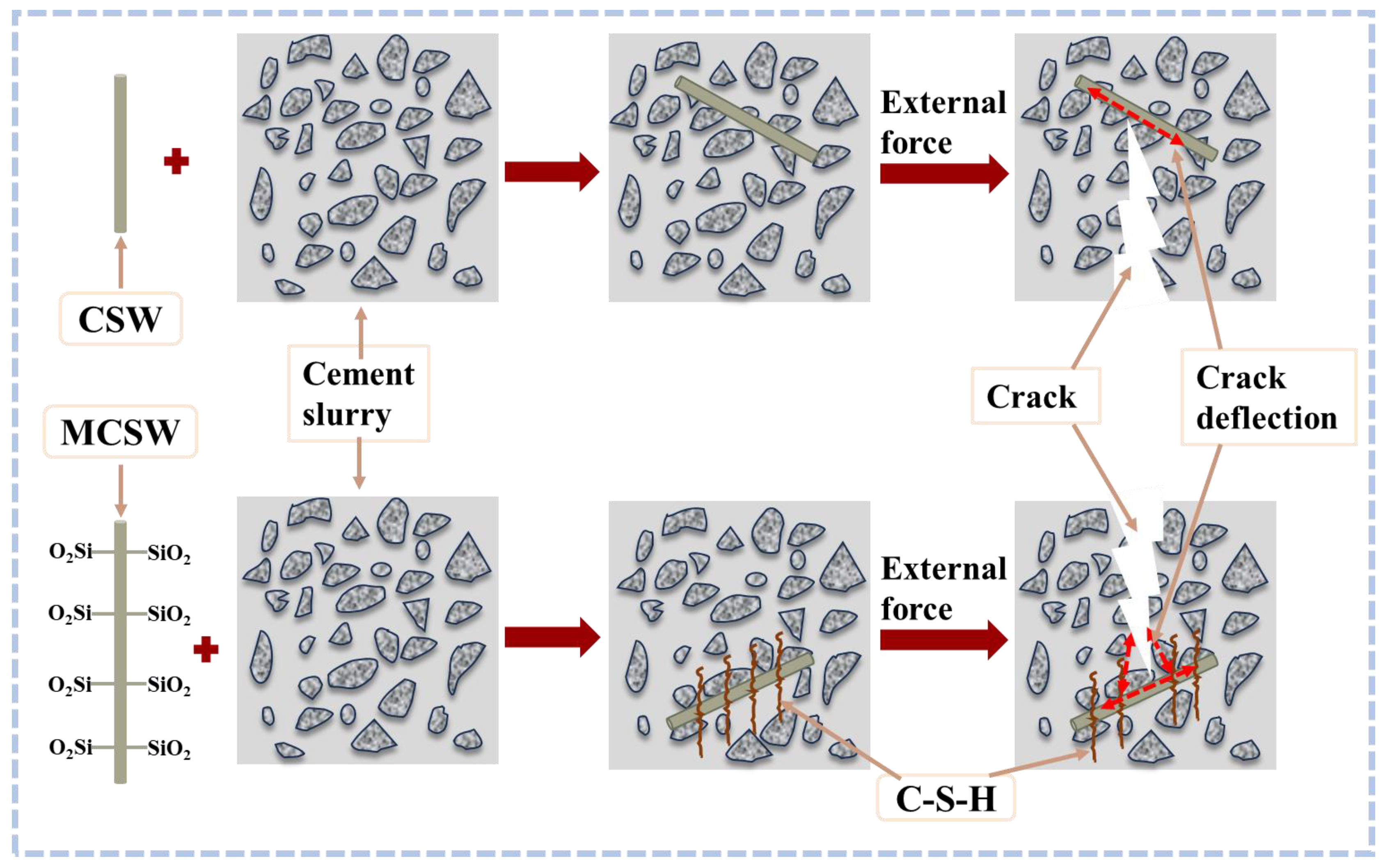
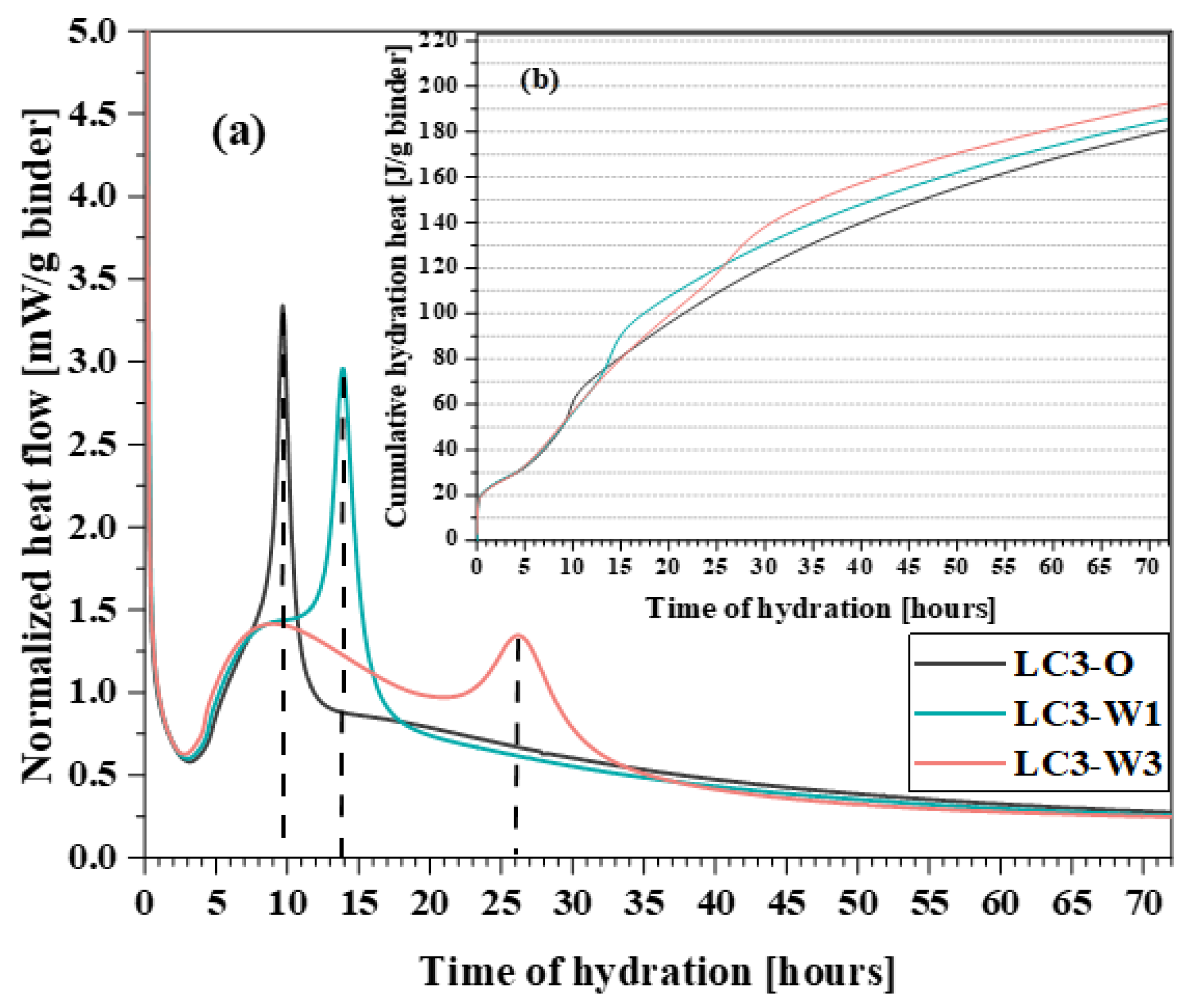
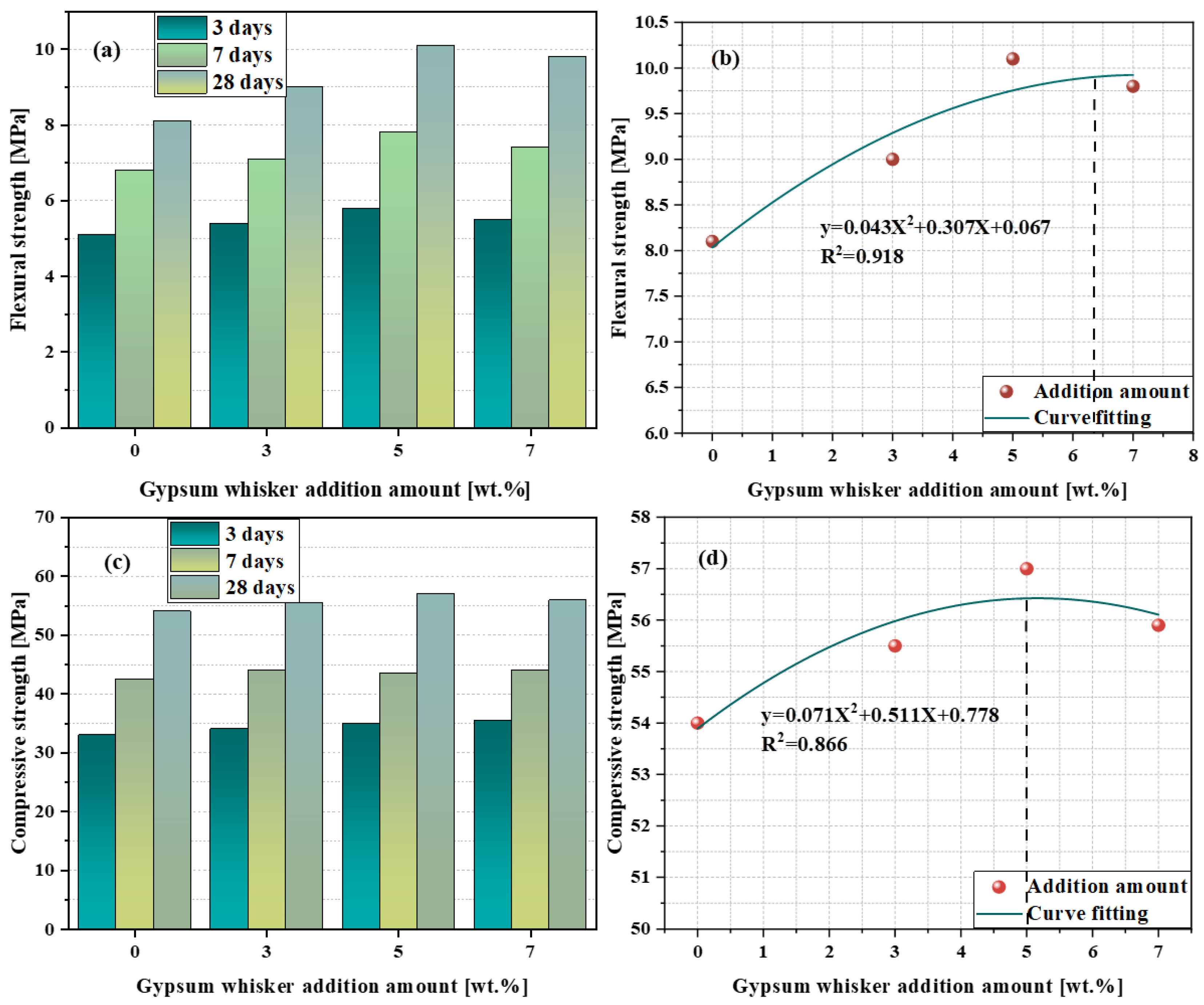
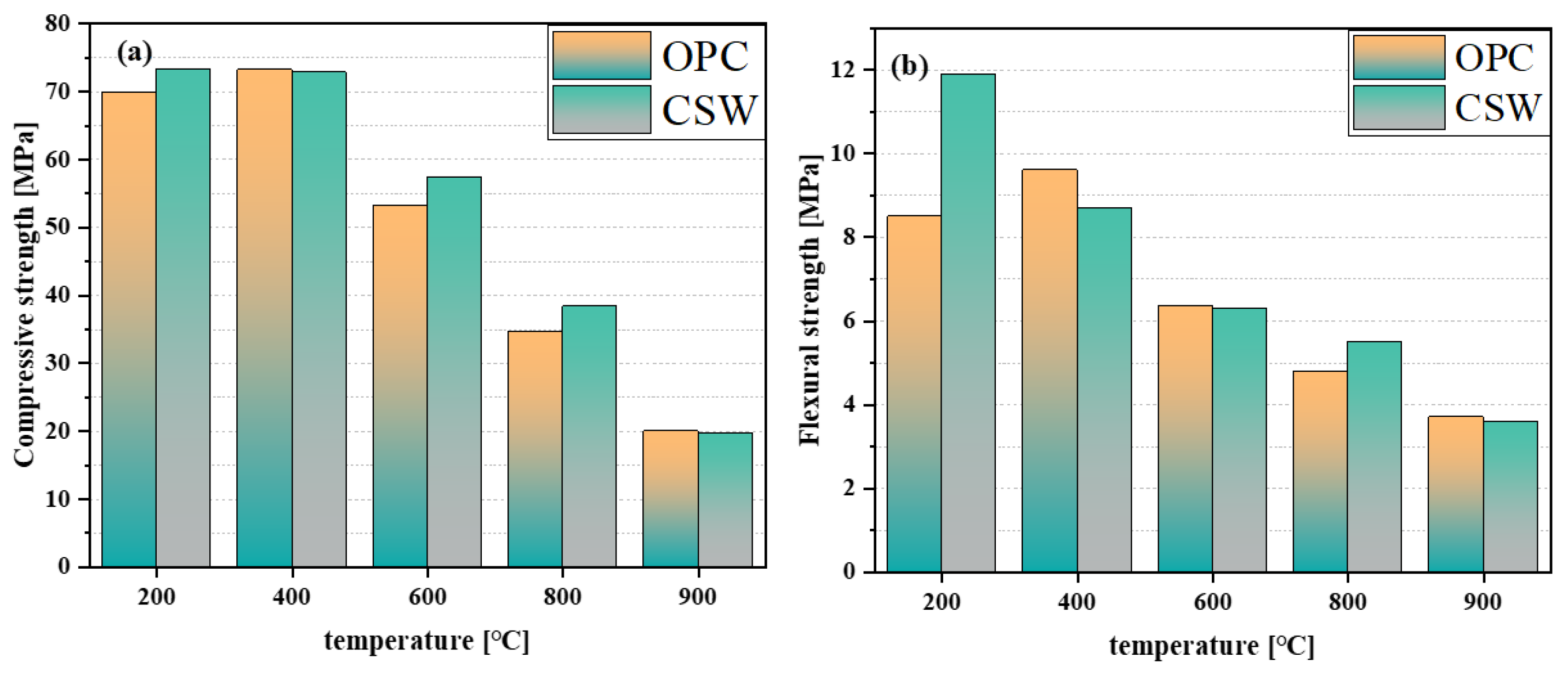
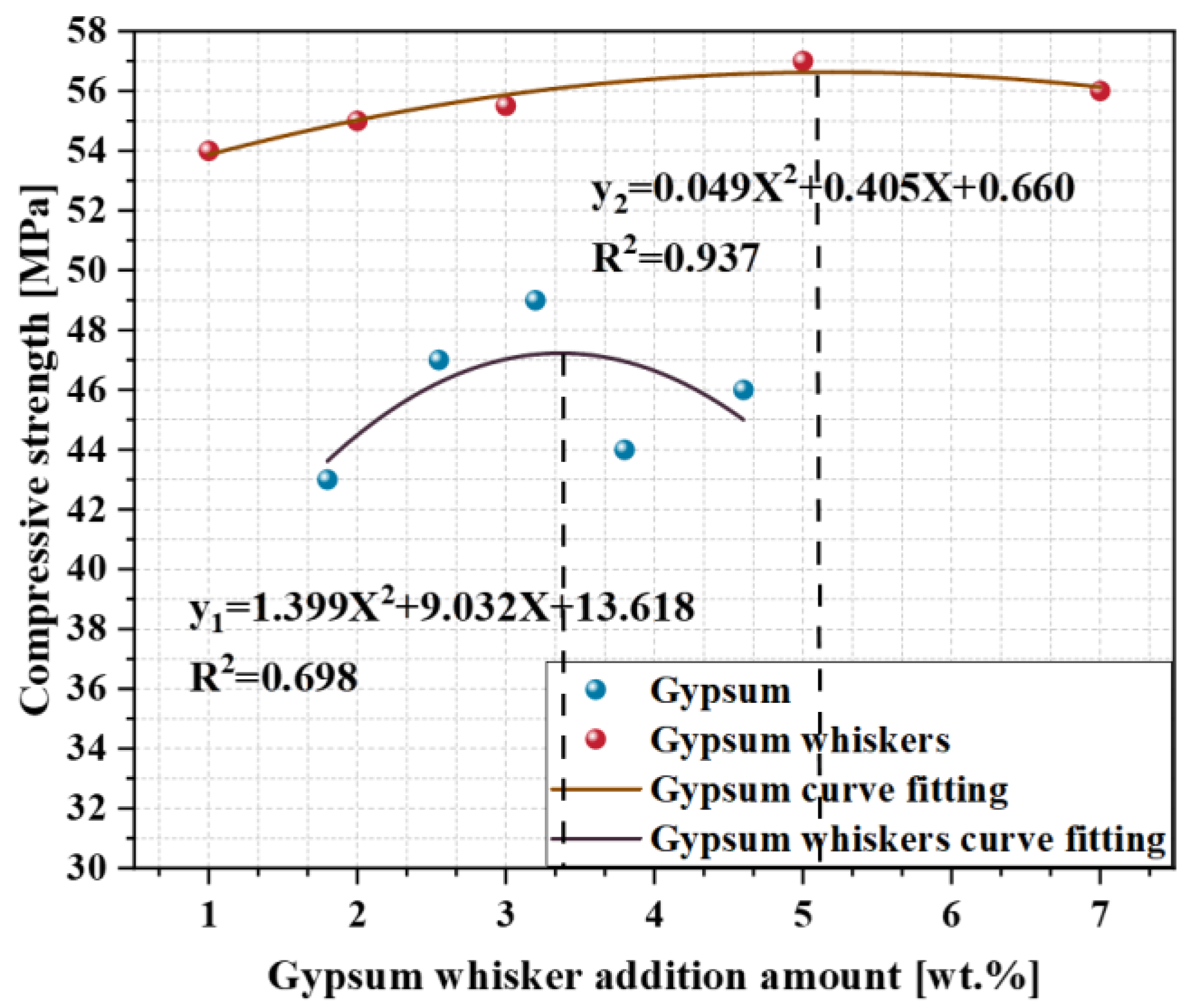

| Preparation Method | Advantage | Disadvantages | Influencing Factors | References |
|---|---|---|---|---|
| Hydrothermal | High yield, good controllability, wide application range, etc. | High energy consumption, high reaction condition requirements, poor product dispersion, etc. | Reaction temperature, reaction time, reactant concentration, additives, reaction pressure, etc. | [5,22,25,28] |
| Normal pressure acidification method | Low cost, environmentally friendly, wide applicability, etc. | The reaction time is long, the output rate is low, and the product morphology is difficult to control, etc. | Acidifying agent concentration, reaction temperature, reaction time, selection of calcium source and calcium sulfate source, stirring rate, reaction vessel and equipment, etc. | [17,46,47] |
| Ion exchange method | High product quality, simple operation, wide application range, etc. | Higher cost, longer response time, high equipment requirements, etc. | Ion exchange medium, reaction temperature, reaction time, reactant concentration, stirring rate, pH value, etc. | [35,36,48] |
| microemulsion method | Simple operation, high yield, good product dispersion, etc. | The preparation conditions are high, the cost is high, and it is affected by the environment, etc. | Surfactant selection, ratio of oil phase to water phase, reaction temperature, reaction time, stability regulator, etc. | [30,31,41,49] |
| microwave method | High efficiency and energy saving, high product quality, easy operation, wide application range, etc. | It is difficult to control reaction conditions, high equipment costs, and limited selection of reaction systems, etc. | Microwave power, reaction time, reaction temperature, reaction solvent, reaction container, etc. | [43,45] |
| CaSO4 Content/wt.% | Curing Time/d | Flexural Strength Improvement/% | Compressive Strength Improvement/% |
|---|---|---|---|
| 3 | 6.9 | 2.8 | |
| 3 | 7 | 7.7 | 3.7 |
| 28 | 8.4 | 4.2 | |
| 3 | 14.4 | 3.2 | |
| 5 | 7 | 22.2 | 4.1 |
| 28 | 28.3 | 8.5 | |
| 3 | 11.3 | 4.1 | |
| 7 | 7 | 17.5 | 4.7 |
| 28 | 21.8 | 5.6 |
Disclaimer/Publisher’s Note: The statements, opinions and data contained in all publications are solely those of the individual author(s) and contributor(s) and not of MDPI and/or the editor(s). MDPI and/or the editor(s) disclaim responsibility for any injury to people or property resulting from any ideas, methods, instructions or products referred to in the content. |
© 2024 by the authors. Licensee MDPI, Basel, Switzerland. This article is an open access article distributed under the terms and conditions of the Creative Commons Attribution (CC BY) license (https://creativecommons.org/licenses/by/4.0/).
Share and Cite
Liu, G.; Liao, Y.; Sha, X.; Liu, G.; Zhang, Y.; Guo, R.; Yue, Y. Application of Calcium Sulfate Whiskers to Cement-Based Materials: A Review. Materials 2024, 17, 1138. https://doi.org/10.3390/ma17051138
Liu G, Liao Y, Sha X, Liu G, Zhang Y, Guo R, Yue Y. Application of Calcium Sulfate Whiskers to Cement-Based Materials: A Review. Materials. 2024; 17(5):1138. https://doi.org/10.3390/ma17051138
Chicago/Turabian StyleLiu, Guoqiang, Yongpang Liao, Xun Sha, Guangmin Liu, Yingjie Zhang, Rongxin Guo, and Yao Yue. 2024. "Application of Calcium Sulfate Whiskers to Cement-Based Materials: A Review" Materials 17, no. 5: 1138. https://doi.org/10.3390/ma17051138




